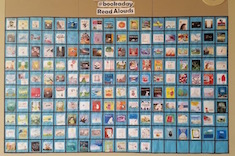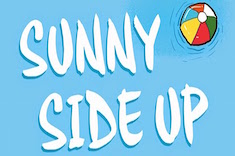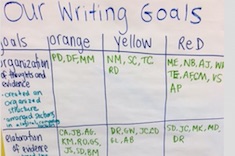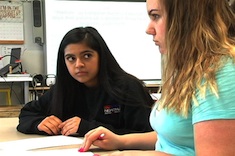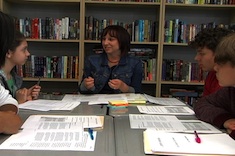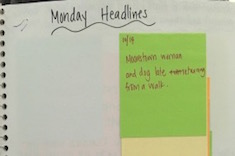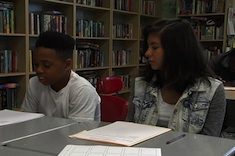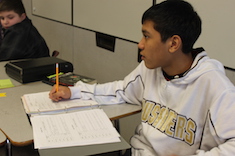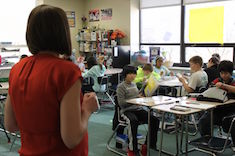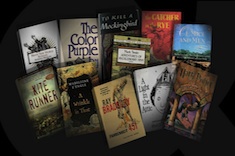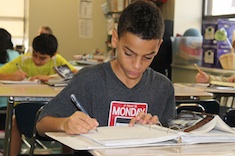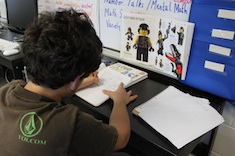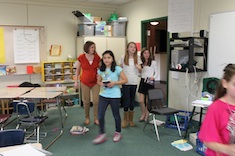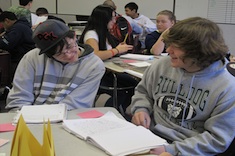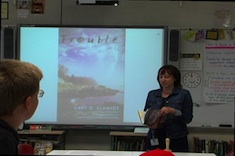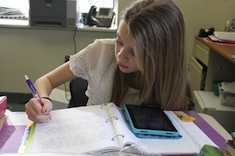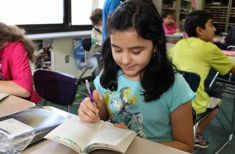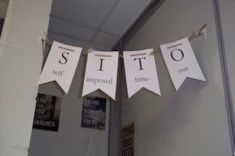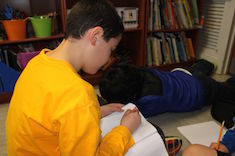7th
Latest Content
#bookaday in Middle School: Nuts and Bolts
Jillian Heise shares advice for teachers who want to try a #bookaday challenge of sharing at least one picture book each day with older students. She gives criteria for book selection, as well as examples of books to read at the start of the school year.
Building Community with a Shared Text
Christy Rush-Levine finds a community of new teachers bonds over a text highlighting addiction struggles. The experience leads her to think through what elements are essential for whole-class texts in her middle school classroom.
#bookaday in Middle School
Jillian Heise rises to the challenge of reading a new picture book to her seventh and eighth graders each day all year long.
Practical Ways to Connect Students and Goals
Kate Mills and Tara Barnett provide some practical tips for connecting students and goals.
Consistent Feedback in Writing Workshop
Carly Ullmer assesses how she can give consistent and meaningful feedback to every one of her many middle school students at least once a week.
Expert Students
Christy Rush-Levine uses a quick assessment during writing workshop conferences to connect expert students with peers who might need assistance. She includes a video example of the practice.
Literary Analysis: Tone and Scholarly Writing
Christy Rush-Levine shares how to help student writers understand and develop a scholarly tone. The feature includes a video example of small-group instruction.
Monday Headlines
Tara Barnett and Kate Mills use Monday Headlines to energize students after the weekend, and get a peek into what’s going on at home.
Literary Analysis: Counterclaims
Christy Rush-Levine shares how to present counterclaims, as well as a video example of a small group exploring counterclaims.
Creating Curiosity with Story
Mark Levine finds that the secret to engaging students in what might be perceived as dry historical topics is to create curiosity with story.
Tracking Student Goals
Carly Ullmer transfers a messy goal-setting protocol to her seventh graders, and in the process finds they take on more accountability for individual success.
Student (and Teacher) Risk-Taking
Carly Ullmer ponders what it means to take risks in her middle school classroom as she and her students experiment with different response options.
Beyond the Comfort Zone: Books for Our Times
Christy Rush-Levine explains why she stocks some books in her middle school classroom library that can provoke concerns from families, and how she deals with conflicts.
The Pocahontas Ewww: Writing and Inquiry for Context
Mark Levine finds his middle school students are appalled by some of the cultural differences from times gone by, and shares how he fosters more understanding.
Better Mondays Through Quick-Writes
Mark Levine uses quick-writes with his middle school students to set the expectation at the start of the week for work together that is independent, thoughtful, and conversational.
Mentors for Process and Habits
Ruth Ayres shares some of her favorite mentors and mentor texts for developing good writing processes and habits.
Superpowers and a Middle School Classroom Library
Christy Rush-Levine explains how she gradually stocked her middle school classroom library, as well as how she uses student librarians to ensure books aren’t lost.
Transition Time in Middle School
Gretchen Taylor considers how she handles hard transitions as an adult, and questions how she can make transitions more efficient and valuable for her middle school students.
Reflective Transitions
Christy Rush-Levine helps her eighth-grade students launch the work period with a reflective question that sets a tone for productivity, and then returns to it throughout the morning during transition times.
“What Are We Learning Today?”: Transitioning with Compelling Questions
Mark Levine helps his seventh-grade students transition to the learning of the day with a "compelling question" posted on the board before each class session.
Beginnings, Middles, and Endings: The Power of Baseline Assessments
Carly Ullmer shares how much her seventh-grade students learn from examining their own growth as writers with baseline, midpoint, and final assessments throughout the year.
Book Talk: Trouble
Christy Rush-Levine previews the book Trouble by Gary D. Schmidt.
Last Chance Workshop
Christy Rush-Levine breaks her routine of responding to student writing, and instead calls on students to guide and support peers. She shares some surprising results.
A Formula for Great Book Talks
Christy Rush-Levine explains her formula for successful book talks in middle school that grab students' attention. We've also included a sample book talk.
Getting Teens Out of Reading Ruts: The Sampler
Carly Ullmer describes the activity she’s developed for getting her middle school readers out of reading ruts by sampling different authors and genres.
Deep Reading of Picture Books in Middle School
Christy Rush-Levine shows the power of using picture books with young adolescents to model close reading and deepen comprehension of sophisticated texts.
SITO: Self-Imposed Time-Out
Christy Rush-Levine takes an oddly shaped unused nook in her classroom and turns it into a charming space where students can choose to take a quiet break with a “Self-Imposed Time-Out” (SITO).
Building Stamina in Middle School Writers
Carly Ullmer finds herself wasting a lot of time because of interruptions during student conferences, so she makes building stamina in her middle school students a priority.
Invitations for Narrative Writing
Kim Campbell suggests activities and prompts to energize narrative writing with teens.
Visual Reading for Writing
Carly Ulmer uses visual literacy to build writing skills with her seventh graders through two powerful minilessons.
Browse Content By
Type
Category
- Assessment Tools
- Big Fresh Archives
- Booklists
- Choice Numeracy
- Classroom Design
- Common Core
- Community Building
- Conferring
- Content Literacy
- Digital Literacy
- English Language Learners
- Equity
- Family Relations
- Free Samples
- Guiding Groups
- Leadership
- Literacy Coaches
- Mentor Texts
- Minilessons
- New Teacher Mentors
- Podcasts
- Poetry
- Quote Collections
- Reading Strategies
- Self Care
- Struggling and Striving Learners
- Talking and Listening
- Teacher Study Groups
- Teaching Reading
- Teaching Writing
- Word Study and Vocabulary
Author
- Melissa Quimby
- Nawal Qarooni
- Gwen Blumberg
- Julie Cox
- The Lead Learners
- Hannah Tills
- Josie Stewart
- Ruth Metcalfe
- Mallory Messenger
- Becca Burk
- Jodie Bailey
- Vivian Chen
- Mary Brower
- Tiffany Abbott Fuller
- Stephanie Affinito
- Ruth Ayres
- Leigh Anne Eck
- Heather Fisher
- Shari Frost
- Julie Johnson
- Suzy Kaback
- Gigi McAllister
- Shirl McPhillips
- Melanie Meehan
- Cathy Mere
- Debbie Miller
- Tara Barnett and Kate Mills
- Tammy Mulligan
- Dana Murphy
- Bitsy Parks
- David Pittman
- Brenda Power
- Heather Rader
- Matt Renwick
- Mandy Robek
- Christy Rush-Levine
- Gretchen Schroeder
- Jen Schwanke
- Brian Sepe
- Katherine Sokolowski
- Stella Villalba
- Jennifer Vincent
Grade Level
Choice Literacy Membership
Articles
Get full access to all Choice Literacy article content
Videos
Get full access to all Choice Literacy video content
Courses
Access Choice Literacy course curriculum and training

